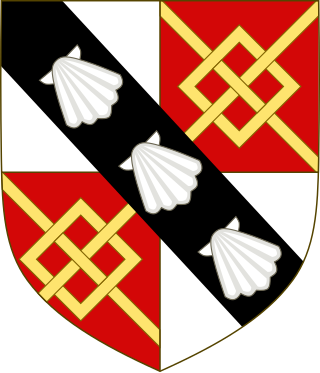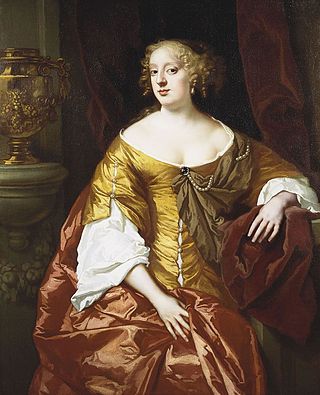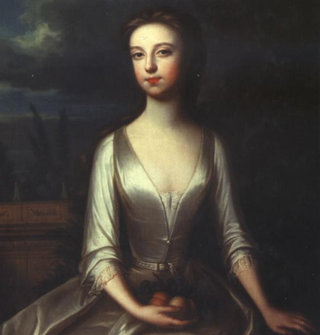
Duke of Marlborough is a title in the Peerage of England. It was created by Queen Anne in 1702 for John Churchill, 1st Earl of Marlborough (1650–1722), the noted military leader. In historical texts, unqualified use of the title typically refers to the 1st Duke. The name of the dukedom refers to Marlborough in Wiltshire.

The Spencer family is an aristocratic family in the United Kingdom. From the 16th century, its members have held numerous titles including the dukedom of Marlborough, the earldoms of Sunderland and Spencer, and the Churchill barony. Two prominent members of the family during the 20th century were Sir Winston Churchill and Diana, Princess of Wales.

Robert Spencer, 2nd Earl of Sunderland, was an English nobleman and politician of the Spencer family. An able and gifted statesman, his caustic temper and belief in absolute monarchy nevertheless made him numerous enemies. He was forced to flee England in 1688, but later established himself with the new regime after the Glorious Revolution of that year. Subsequently, he took on a more disinterested role as an adviser to the Crown, seeking neither office nor favour. He evinced no party loyalty, but was devoted to his country's interests, as he saw them. By the notoriously lax standards of the Restoration Court, his private life was remarkably free from scandal, which won him favour in the more sober post-Revolution state.

John Winston Spencer-Churchill, 7th Duke of Marlborough,, styled Earl of Sunderland from 1822 to 1840 and Marquess of Blandford from 1840 to 1857, was a British Conservative cabinet minister, politician, peer, and nobleman. He was the paternal grandfather of Prime Minister Sir Winston Churchill.

Charles Edward Montagu, 1st Duke of Manchester, was a British aristocrat and statesman.

Earl of Sunderland is a title that has been created twice in the Peerage of England. The first creation came in 1627 in favour of Emanuel Scrope, 11th Baron Scrope of Bolton. The earldom became extinct on his death in 1630 while the barony became either extinct or dormant. The second creation came in 1643 in favour of the Royalist soldier Henry Spencer, 3rd Baron Spencer of Wormleighton. The Spencer family descended from Sir John Spencer who acquired the Wormleighton estate in Warwickshire and the Althorp estate in Northamptonshire. His grandson Sir John Spencer was a Knight of the Shire for Northamptonshire. The latter's grandson Sir Robert Spencer represented Brackley in Parliament in the late 16th century. In 1603 Sir Robert was raised to the Peerage of England as Baron Spencer of Wormleighton. He was succeeded by his eldest surviving son, William, the second Baron. He had previously represented Northamptonshire in Parliament. His eldest son was the aforementioned third Baron. In July 1643 he was created Earl of Sunderland in the Peerage of England. Lord Sunderland was killed at the Battle of Newbury in September of the same year. He was succeeded by his two-year-old only son, Robert, the second Earl. He later gained great distinction as a statesman and notably served four times as Secretary of State for the Southern Department.

Charles Spencer, 3rd Duke of Marlborough,, styled as The Honourable Charles Spencer between 1706 and 1729 and as The Earl of Sunderland between 1729 and 1733, was a British soldier, nobleman, and politician from the Spencer family. He briefly served as Lord Privy Seal in 1755. He led British forces during the Raid on St Malo in 1758.
Donough MacCarthy, 4th Earl of Clancarty (1668–1734) fought for James II in the Williamite War in Ireland at the Siege of Derry. He was attainted in 1691 after the defeat. MacCarthy went into exile to the Netherlands, where he lived for some time on the tiny island of Rottumeroog, and in Germany near Hamburg where he died.

Henrietta Godolphin, 2nd Duchess of Marlborough was the daughter of John Churchill, 1st Duke of Marlborough, general of the army, and Sarah Jennings, Duchess of Marlborough, close friend and business manager of Queen Anne.

Scroop Egerton, 1st Duke of Bridgewater, styled as Viscount Brackley from 1687 to 1701 and as the Earl of Bridgewater from 1701 to 1720, was an English peer, courtier and landowner. Born into the Egerton family, he succeeded as Earl of Bridgewater in 1701, before being created Duke of Bridgewater on 18 June 1720, with subsidiary titles including Marquess of Brackley.

John Spencer, 1st Earl Spencer was a British peer and politician.

Anne Spencer, Countess of Sunderland was the wife of Robert Spencer, 2nd Earl of Sunderland and the daughter of George Digby, 2nd Earl of Bristol and Lady Anne Russell.

Francis Almeric Spencer, 1st Baron Churchill DCL FRS was a British peer and Whig politician from the Spencer family.

Diana Russell, Duchess of Bedford, was a member of the Spencer family, chiefly remembered because of an unsuccessful attempt to arrange a marriage for her with Frederick, Prince of Wales.

John Spencer was an English politician who sat in the House of Commons from 1732 to 1746.

Anne Spencer, Countess of Sunderland, was an English court official and noble. She held the office of Lady of the Bedchamber to Queen Anne from 1702 to 1712.
Gentleman of the Bedchamber was a title in the royal household of the Kingdom of England from the 11th century, later used also in the Kingdom of Great Britain. A Lord of the Bedchamber was a courtier in the Royal Household; the term being first used in 1718. The duties of the Lords and Gentleman of the Bedchamber originally consisted of assisting the monarch with dressing, waiting on him when he ate, guarding access to his bedchamber and closet and providing companionship. Such functions became less important over time, but provided proximity to the monarch; the holders were thus trusted confidants and often extremely powerful. The offices were in the gift of The Crown and were originally sworn by Royal Warrant directed to the Lord Chamberlain.
Robert Spencer, 4th Earl of Sunderland was a British peer from the Spencer family, the son of Whig politician Charles Spencer, 3rd Earl of Sunderland. His mother was Lady Anne Churchill, the daughter of John Churchill, 1st Duke of Marlborough, and Sarah Churchill, Duchess of Marlborough. Known as Lord Spencer between 1702 and 1722, he succeeded to the Earldom after his father's death in 1722, but died in 1729 with no children. Therefore, his brother, Charles, became 5th Earl of Sunderland, and subsequently 3rd Duke of Marlborough after the death of his aunt, Henrietta Godolphin, 2nd Duchess of Marlborough.

William Godolphin, Marquess of Blandford was an English nobleman and politician who sat in the House of Commons between 1720 and 1731.

Elizabeth Spencer, Duchess of Marlborough, formerly the Hon. Elizabeth Trevor, was the wife of Charles Spencer, 3rd Duke of Marlborough.

















